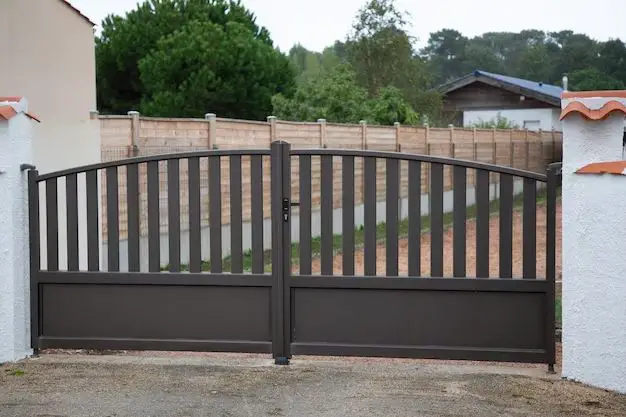Making a double gate secure is an important consideration for homeowners and businesses looking to enhance the security of their property. A double gate setup typically consists of two gates side-by-side that both need to be opened to allow access. This added layer of security makes it harder for intruders to gain entry and provides peace of mind. However, simply installing two gates next to each other does not guarantee security – there are several steps that need to be taken to make a double gate truly secure. In this article, we will explore the key factors to consider when making a double gate secure.
Page Contents
What are the benefits of a double gate?
There are several advantages that a double gate system provides over a single gate:
– Added security – Having two gates that both need to be opened makes it much harder for intruders to sneak through. Even if they are able to breach one gate, they still have to get past the second.
– Access control – Double gates allow tighter control over who is allowed access to the property. Both gates can be locked, requiring keys or passcodes to open each one.
– Traffic flow – The gates can be used to direct foot traffic and vehicles in an orderly manner. One gate can be designated for entry, while the other is for exiting.
– Aesthetic appeal – Double gates have an attractive, upscale look that can enhance the curb appeal of homes and businesses. The symmetry of two matching gates is visually appealing.
What factors make a double gate secure?
There are several important factors that contribute to making a double gate setup secure:
Strong and sturdy gate construction
The gates themselves need to be made of robust, durable materials to withstand force. Steel and wrought iron are excellent choices that will resist cutting, sawing, and battering attempts. The hinges and latches also need to be made of strong forged metal.
Proper gate height and width
For optimal security, each gate should be at least 6 feet high to make climbing over difficult. The gates should fully span the gateway width to eliminate gaps at the sides. Leave no more than 2-3 inches between the gates when closed.
High-quality, tamper-proof locks
Invest in heavy-duty padlocks, multi-point locking systems, or electronic access control systems. Chain and combination locks alone are too easy to cut or break. Choose locks that use strong metals like hardened steel or are shrouded to resist bolt cutters or hammer blows.
Security hinges
Normal gate hinges are vulnerable points that intruders can target to lift gates off. Use secure hinges with integrated locking mechanisms to prevent gate removal. Or opt for concealed hinges for even greater security.
Supplementary barriers
Install barriers like fences, walls, thick vegetation, or ditches around the gate perimeter. This provides an extra layer of security and makes the property harder to access overall.
Alarm systems
Having audible alarms on the gates which activate when opened without authorization can deter intruders. Gate motion detectors and security cameras provide additional monitoring.
Limited key distribution
Only give gate keys or passcodes to essential individuals. Retain master keys under strict controls. Re-key if any keys become lost or compromised.
Best practices for installation and use
Proper installation and usage habits are also important for double gate security:
– Hire professional technicians to install the gates and integrate locks, alarms, and access systems. DIY is riskier.
– Make sure the gates open inward and freely swing both ways without scraping the ground. Anything impeding movement is a weakness.
– Keep the gates properly maintained with regular inspections and upkeep. Lubricate hinges, check alignment, and perform repairs as needed.
– Always keep gates locked when not in use. Never rely on them being left open and unattended.
– Avoid sharing keys or passcodes widely. Only authorized individuals should have access.
– Change passcodes and re-key locks periodically as a precaution. Also re-key if keys become lost or stolen.
– Make sure all gate hardware, locks, and alarm systems are sufficiently weather-resistant. Exposure to elements can cause deterioration or malfunction over time.
Additional security measures
While the gates themselves are the primary barrier, implementing complementary security measures can provide further protection:
– Install security lighting around the perimeter to eliminate dark spots intruders could use for concealment.
– Have a guard house or gatekeeper stationed at the entrance to screen and control access.
– Use security patrols or dogs to monitor the premises after hours.
– Post warning signs stating the property is under video surveillance and monitored by a security company.
– Eliminate landscaping or obstructions around the gates that could provide hiding spots.
– Position bollards or barriers in front of the gates to prevent vehicles from ramming through.
– Keep trees and vegetation trimmed back from the gates so they cannot be used for climbing.
Conclusion
Installing a double gate can significantly enhance property security, but only if the proper precautions are followed. Paying close attention to the strength of gate and hardware materials, supplementary barriers, quality locks, and professional installation is crucial. Following best practices for access control, maintenance, and monitoring also ensures maximum security. A double gate setup integrated with layers of additional security measures can create a formidable barrier against unauthorized entry. Taking a comprehensive approach helps realize the full benefits of a double gate installation.
